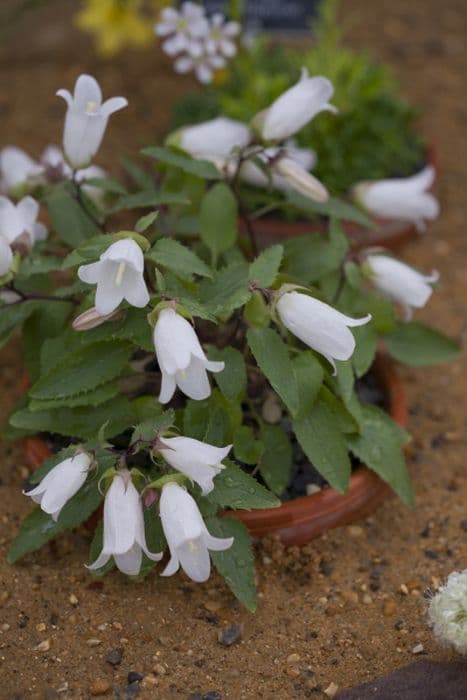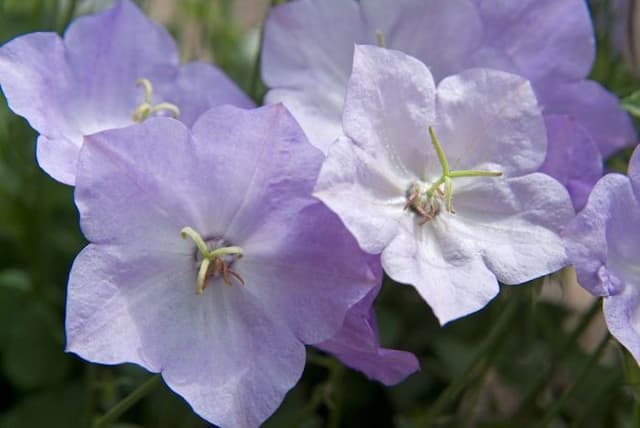Harebell Campanula rotundifolia

ABOUT
The common name of Campanula rotundifolia is harebell. This plant bears a graceful and delicate appearance, often noted for its charming bell-shaped flowers. The blooms are typically a vibrant shade of blue to violet, though occasionally they can appear white, and hang from thin, thread-like stalks. The base of the plant features a rosette of rounded to heart-shaped leaves, which are usually green in hue. As the plant stalk ascends, the leaves become narrower, linear, and more sparsely arranged. Its rounded blossoms, with their petal edges slightly turned back, give it a whimsical, fairy-like look, making it a delightful sight in its natural habitats. The slender stem of the harebell, combined with its eye-catching flowers, adds a touch of elegance to the areas where it grows.
About this plant
 Names
NamesFamily
Campanulaceae.
Synonyms
Bluebell Bellflower, Harebell, Bluebell-of-Scotland, Scottish Bellflower, Witch's Thimble, Lady's Thimble, Fairy Thimble, Auld Man's Bell, Dead Men's Bells, Heath Bell, Witches' Bells, Devils' Bells.
Common names
Campanula linifolia, Campanula oreadum, Campanula ovalis, Campanula rhomboidea, Campanula saxatilis, Campanula schistocalyx, Campanula stenocodon, Campanula strophiata, Campanula subulata, Campanula turbinata, Campanula vahliana, Campanula versicolor, Symphyandra rotundifolia, Campanula caesia, Campanula gieseckiana, Campanula hyperborea, Campanula intercedens.
 Toxicity
ToxicityTo humans
Harebell (Campanula rotundifolia) is not known to be toxic to humans. Generally, Harebells are considered safe, and there are no well-documented cases of poisoning from ingestion of this plant. However, as with any plant, individual allergies or sensitivities could possibly occur. Ingesting any part of the plant should not cause any toxicity or symptoms associated with poisoning.
To pets
Harebell (Campanula rotundifolia) is not known to be toxic to pets either. It is regarded as a non-toxic plant for domestic animals such as dogs and cats. There are no typical symptoms associated with poisoning since the Harebell is not considered poisonous. Ingesting this plant should not lead to any adverse health consequences for pets. However, it is always wise to monitor pets for any unexpected reactions if they ingest plant material, as individual sensitivities can vary.
 Characteristics
CharacteristicsLife cycle
Perennials
Foliage type
Deciduous
Color of leaves
Green
Flower color
Blue
Height
1 foot (30 cm)
Spread
1 foot (30 cm)
Plant type
Herb
Hardiness zones
3-7
Native area
Europe
Benefits
 General Benefits
General Benefits- Attracts Pollinators: Campanula rotundifolia, commonly known as harebell, provides nectar and pollen for bees, butterflies, and other beneficial insects.
- Aesthetic Appeal: With its delicate blue or violet bell-shaped flowers, harebell adds beauty and charm to gardens and natural landscapes.
- Drought Tolerance: Harebell is well adapted to survive in dry conditions once established, making it suitable for low-water gardens.
- Wildlife Habitat: The plant offers shelter and breeding spots for various small insects, contributing to biodiversity.
- Low Maintenance: Harebell is generally easy to care for and does not require frequent watering or fertilizing, making it ideal for low-maintenance gardens.
- Adaptability: This species can thrive in a variety of soil types and environmental conditions, from full sun to partial shade.
- Erosion Control: The root system of harebell helps stabilize soil and control erosion on slopes and in wild areas.
- Edible Parts: Although not well-known for its culinary uses, young harebell leaves can be eaten in small quantities and are said to add a mild flavor to salads.
 Medical Properties
Medical Properties- Anti-inflammatory: Campanula rotundifolia has traditionally been used for its purported anti-inflammatory properties.
- Diuretic: The plant has been considered to have diuretic effects, promoting the production of urine.
- Astringent: It has been used as an astringent to tone and tighten tissues and relieve irritations.
- Pulmonary complaints: Harebell has been used in folk medicine for treating coughs and other pulmonary issues.
- Skin healing: It has been applied topically in some traditional practices to promote skin healing and treat minor wounds.
 Air-purifying Qualities
Air-purifying QualitiesThis plant is not specifically known for air purifying qualities.
 Other Uses
Other Uses- Campanula rotundifolia, commonly known as harebell, is traditionally used in Scottish folklore when invoking the fairies, as it was believed to be a flower that attracted these mythic beings.
- The harebell has been used historically as an edible plant; young leaves are consumed raw in salads or cooked like spinach, providing a mild flavor to various dishes.
- In some cultures, the harebell is associated with grief and mourning, and thus it can be found in arrangements designed for funerals or remembrance ceremonies.
- The delicate appearance of harebells makes them a favorite for cottage gardens and informal garden settings, contributing to aesthetic design rather than functionality.
- Harebells are employed in natural dye making, producing colors ranging from green to a yellow-brown depending on the mordant used.
- This plant is often used by nature photographers and artists as a subject due to its picturesque form and the way it sways gracefully in the wind.
- Its whimsical shape and endurance in rocky terrain make harebell a symbol of resilience and has inspired its use in poetry and literature to embody these traits.
- Besides human uses, harebell flowers are an important source of nectar for pollinators, such as bees, butterflies, and hummingbirds, supporting biodiversity.
- The roots of harebells have been used as a natural fish poison in some indigenous practices, taking advantage of compounds that affect fish respiration.
- In fiber arts, the delicate form of harebell flowers can be used as a motif for embroidery or fabric prints, exemplifying the beauty of wild flora.
Interesting Facts
 Feng Shui
Feng ShuiThe Harebell is not used in Feng Shui practice.
 Zodiac Sign Compitability
Zodiac Sign CompitabilityThe Harebell is not used in astrology practice.
 Plant Symbolism
Plant Symbolism- Vitality: Campanula rotundifolia, commonly known as Harebell, is often associated with vitality because it thrives in a variety of conditions and its delicate-looking blue flowers continue to bloom even in challenging environments.
- Constancy and Perseverance: The Harebell symbolizes constancy and perseverance due to its ability to return each year with renewed strength and its unwavering bloom throughout the seasons.
- Humility: The small size and delicate structure of the Harebell flowers represent humility, reminding us of the beauty and strength found in modesty.
- Gratitude: Giving someone Harebells is a way to express gratitude, as the plant represents thankfulness for a deep and meaningful connection.
- Enduring Love: In some traditions, Harebells are symbols of enduring love, often shared between friends or family members who have a lasting bond regardless of distance or time.
 Water
WaterThe Harebell, commonly known as Campanula rotundifolia, should be watered thoroughly, ensuring that the soil is evenly moist but not waterlogged. During active growth in spring and summer, water the plant once a week with approximately one gallon per square foot, depending on the size of the plant and environmental conditions. In the fall and winter months, reduce watering to every two weeks or less, depending on the plant's needs and the humidity of the environment. Always check the top inch of soil for dryness before watering again. Overwatering can lead to root rot, so it is vital to let the soil dry out slightly between watering sessions.
 Light
LightHarebell thrives best in full sun to partial shade conditions. Ideally, place the plant in a location where it can receive at least six hours of sunlight per day. This plant is tolerant of various lighting conditions but will flower most abundantly when provided with ample sunlight. Avoiding deep shade is important as it could impede the plant's growth and reduce flowering.
 Temperature
TemperatureHarebell prefers a moderate temperature range and can survive in temperatures as low as 20°F and as high as 85°F. The ideal temperature for Harebell is between 60°F and 70°F, ensuring healthy growth and flowering. It is a hardy plant that can withstand cooler temperatures, especially when established.
 Pruning
PruningHarebell benefits from occasional pruning to remove spent flowers and to encourage bushier growth and more blooms. Prune lightly in the spring or early summer, after the first wave of flowering, to tidy up the plant and stimulate a second flush of blooms. Pruning too late in the season can harm the plant's ability to prepare for winter.
 Cleaning
CleaningAs needed
 Soil
SoilHarebell thrives in well-draining, loamy soil with a pH range of 6.0 to 7.5. A mixture of two parts garden soil, one part peat moss, and one part perlite or coarse sand is ideal.
 Repotting
RepottingHarebells should be repotted every two to three years to prevent overcrowding and to refresh the soil.
 Humidity & Misting
Humidity & MistingHarebell prefers moderate humidity levels, but it is quite adaptable and can tolerate both dry and humid conditions as long as proper soil moisture is maintained.
 Suitable locations
Suitable locationsIndoor
Place harebell in bright, indirect light; water moderately.
Outdoor
Plant in well-drained soil, full or partial sun; water as needed.
Hardiness zone
3-8 USDA.
 Life cycle
Life cycleCampanula rotundifolia, commonly known as harebell or bluebell bellflower, begins its life cycle with seed germination, typically occurring in spring when soil temperatures warm. After germination, it develops into a small rosette of basal leaves during its first year, a stage characterized by vegetative growth. In its second year and subsequent years, harebell sends up flowering stalks that can reach up to 30 cm tall, displaying its bell-shaped blue to violet flowers from June to September. These flowers are pollinated by insects, after which they set seed in small capsules. Once mature, seeds are dispersed by wind, allowing the plant to colonize new areas. The harebell is a perennial, and after setting seed, it can survive the winter in a dormant state, with new growth resuming from the rootstock the following spring.
 Propogation
PropogationPropogation time
Spring to early summer
The best time to propagate Harebell, or Campanula rotundifolia, is early spring to late summer, taking advantage of the plant's natural growing season. The most popular method is by seed sowing, either directly into the soil where they are to grow, or in pots or trays if starting them indoors. Sow the seeds thinly onto the surface of pre-moistened, well-draining soil and barely cover them with a thin layer of soil or vermiculite, as they need light to germinate. Keep the soil moist but not waterlogged, and at a temperature around 68°F (20°C). Germination typically takes 14-28 days. Once seedlings have grown large enough to handle, they can be transplanted into individual pots and later moved to their final position in the garden.









![Milky bellflower [Avalanche]](/_next/image?url=https%3A%2F%2Fplants-admin.emdemapps.com%2Fimages%2Fplants%2F%2Fimages%2F604b5dc88c1e7.png&w=640&q=75)